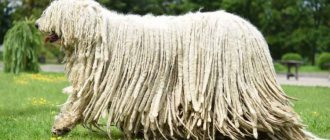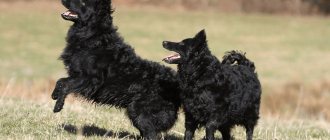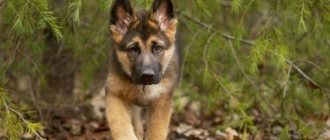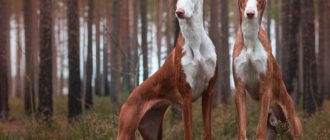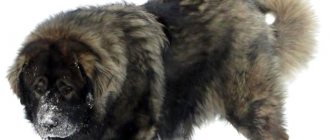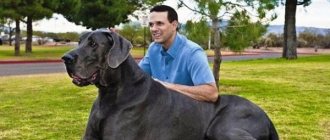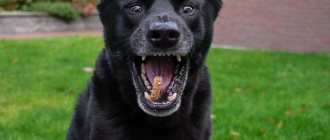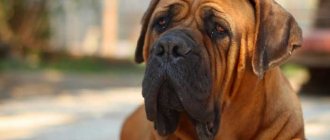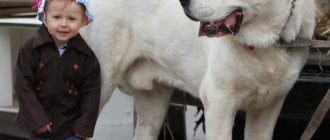Origin of the Komondor breed
The first mention of the breed was found more than 3 thousand years ago. The kings of ancient Babylon dedicated an entire section of the code of laws of that time to the dog. Due to its unusual appearance, the Komondor immediately began to be used as an assistant to shepherds. Thick tufts of wool allow the animal to remain invisible among a flock of sheep. If attacked by a bear or wolf, the Komondor waits for the right moment and attacks the enemy.
History says that the dog's guarding activities in Hungary led to the almost complete extermination of wolves several centuries ago. The dog came to Hungary along with the nomadic Magyar tribes. The breed was bred from Tibetan dogs. The lion's share of dog breeders believe that the Komondor was “born” as a result of crossing dogs and wolves. From the latter, according to breeders, the Komondor received such a fighting character.
In 1544, the animal was first called “commander” (correct spelling: ComOndor). The breed is mentioned in a novel by the writer Kheltai in 1566. After which the animal became a frequent literary hero in the works of other Hungarian writers. The development and appearance of the breed was primarily influenced by environmental factors, thanks to which the dog received thick hair and hunting habits.
The breed gained worldwide recognition in 1920, when the Komondor became a full participant in the European dog show. Over time, the animal's appearance changes and becomes more well-groomed. The breed is very rare today. The smallest number of dogs is in Russia - up to 500 representatives. The largest number of Komondors in their historical homeland is Hungary - about 3,200 dogs.
Kinds
The Hungarian kennel of József Bukowski “Karcagpusztai” was the center through which the breed was recognized throughout the world. Wartime became a test of survival, many dogs died. The commanders served in the army and took part in the battles of the Second World War.
The breed was saved with the support of the population of the American version of the Commander, created by Hungarian immigrants in the pre-war period. Today, the largest number of dogs remains in Hungary and America. A variety of true white commanders is the black commander . Mestizos are not a separate breed. They express the desire of breeders to achieve the appearance of rare colored individuals.
The related breed Puli resembles a small commander. Popular in Hungary as a herding dog, an excellent companion for active people. The dog was recruited to serve as a police officer and search for explosives. Dynamic, hardy, with excellent guarding qualities, the breed has become popular in different countries.
Description of the breed
The Commander has one of the most unique and memorable looks in the dog world. These are very large dogs, and also pure white in color. And their fur forms long cords, reminiscent of dreadlocks.
- Ancient dog breeds
- Dog's sense of smell
- Maine Coon
- Domestic iguana
- How much does a raccoon cost?
- Interesting facts about cats
Hungarian breeders say that if a dog is not large, then it is not a Komondor. Males can reach more than 80 cm at the withers, females 65-70 cm. However, there are no restrictions on the maximum; the taller the dog, the more expensive it is. With this height, Hungarian Shepherds weigh relatively little, males 50–60 kg, females 40–50. For example, similar-sized English Mastiffs weigh 80-110 kg.
The dog's head is hidden under long cords and fur, underneath which lies a short muzzle with a very strong bite force. The dog's eyes should be dark brown or almond. The ears are drooping and v-shaped.
The main feature of the breed is wool. It should be white, although not always pure white, sometimes it is darker due to dirt, since the dog is rarely washed. Some puppies have cream-colored spots that fade with age. Ideal dogs have a bluish-gray skin color, although some may exhibit an undesirable shade of pink.
The coat is very long, slightly shorter on the back, neck and face. Like most other breeds, puppies are born with a soft, curly coat; as they grow older, the coat lengthens and begins to curl, gradually forming cords.
The cords reach 20–27 cm in length and grow slowly. Around two years of age, they are finally formed, and the required length is reached only in the 5th year of life. However, by the age of two, the dog should already have formed the main cords that cover the entire body.
For proper formation, they need to be braided, otherwise the dog will turn into one large, matted ball of hair. But they shed minimally, the largest shedding occurs in the puppy when the puppy fluff falls out. Traditionally, such hair protected the dog from the bites of wolves, which could not bite through it. It takes two and a half days for it to dry completely after washing.
The tail is carried low, never high. At first glance, it seems that the dog does not have a tail at all, since it is completely hidden under the cords.
Komondor coat and colors
As already noted, the main feature of Komondors is their coat; it is predominantly white, but since the dogs can get very dirty, it becomes darker. In puppyhood, there are individuals with cream-colored spots, but in adult dogs they turn pale. Dogs with ideal standard qualities have bluish-gray skin, although dogs often have pink skin, which is undesirable.
The coat is long, somewhat shortened in the area of the back, neck and muzzle. Hungarian Shepherd puppies have soft, curly fur, but it becomes longer with age. Harnesses begin to form in infancy. Dogs do not have undercoat; the “baby” down of dogs falls out by 24 months. And all the fur that grows and falls out remains on the animal and is woven into strands, making them gradually thicker and thicker.
The length of "dreads" reaches an average of 25 cm, but growth slows down. By the age of two they are fully formed into the main cords, and they become maximally long only by the age of five. In order for the harnesses to form correctly and cover the entire body, owners should braid them. Otherwise, the pet will become one giant, matted ball of wool.
Character of Komondors
Hungarian Shepherds are true watchdogs and quite independent dogs, but this in no way detracts from their affection for their family members. But they have no trust in strangers; they are always suspicious of newcomers. It will take a lot of time for the dog to begin to trust, but then the pet will remember the person for a long time and will always greet him joyfully.
- Aggression . If poorly socialized, Komondors can become aggressive towards strangers.
- Instinct of protection . Dogs have a genetically built instinct to protect their own territory, and they will do this regardless of whether their owners want it or not. If you need a four-legged friend who will be a guard and protector of your family and property, then representatives of this breed are what you need.
- Leash . When choosing a Hungarian Shepherd puppy, it is worth considering that you cannot take them out without a leash, as the dog may suspect malicious intent in people passing by. Breeders and owners are unanimous - Komondors are great pets for some, but not for all. The period of growing up in animals is long. They can behave like puppies for a long time. The purpose of Komondors is to guard and protect livestock, and they take their activities responsibly. Dogs will protect any person or animal they consider to be a member of their pack, and will not show aggression towards them without any good reason.
- Jealousy . But they are jealous of outside invasion, and the appearance of other animals, including dogs, on their territory will definitely not please them. They can pounce and drive off strangers, and given their size and centuries of experience in fighting predators, they can not only cause serious injury, but also kill. Those who are familiar with the habits of Komondors say that it is easy to get into the territory of these dogs, but it is extremely difficult to leave.
Application
Initially, the Komondor dog, like the Kangal , was bred to guard sheep flocks and protect them from predators. The Hungarian Shepherd made the right decisions and acted independently without any prompting from its owner.
She is an excellent watchman, and when an enemy approaches, she quickly attacks and behaves mercilessly.
In the USA, the Komondor occupies a leading position in the list of dogs in demand by the police and security services. They act as service dogs, like the Groenendael , and also as bodyguards for high-ranking officials, including the president of the country. Their main duty is to search for explosives.
In the United States, there is a specialized kennel in which these guard dogs are bred for a slightly different purpose - the Komondor is trained to help sick people and mentally disabled children
Socialization
The breed's high intelligence allows it to quickly absorb information and respond to environmental factors. At the same time, the pet loves everything new, so when choosing the same type of training, the commander quickly begins to get bored. The consequence of this may be a refusal to carry out the owner’s commands. Therefore, during training sessions, it is necessary to captivate the pet with new information.
During training, it is recommended to use only the “carrot” method. Praise and affection develop positive qualities in the breed, but an aggressive parenting style can lead to the development of bitterness and aggression in the pet.
Gender differences also affect dog training. Bitches are more obedient and pliable, while cables are stubborn. From an early age, it is recommended to socialize the Komondor: introducing him to new people and dogs. Lack of communication with the “environment” can lead to the development of aggressiveness in the breed. The Komondor is a children's best friend. The pet bravely tolerates any games with children and will selflessly protect them in any situation.
Pets get along well with other animals in the family. The commander takes everyone under his protection. Reacts indifferently to other people's children and animals.
Psychology
The behavior and character of an adult Komondor dog largely depends on timely and correct socialization. The puppy should be taught from an early age to communicate with other dogs and people, and also be adapted to different situations.
If these requirements are neglected, then aggression will prevail in the pet’s character.
An animal that develops in a kind, caring atmosphere will become an excellent pet - loving and devoted
- The Komondor matures late - at about three years of age. Looking at the photo, it is impossible to even imagine that such a large dog is capable of acting like a puppy. Every potential owner should know this feature so that the character of a seemingly adult pet does not raise any questions.
- If there is no threat, then representatives of this breed behave calmly. They are completely indifferent to strangers and other people's children. But at the same time they show friendliness towards their owner’s friends.
- The Komondor is always fiercely loyal to its owner and all members of his family. It is very difficult for him to tolerate a change of owner; for this dog such a situation is fraught with stress. And if you choose him as your pet, then remember - this is forever!
- The Hungarian Shepherd is independent and intelligent, but at the same time cunning and stubborn. As a small puppy, she may exhibit leadership tendencies and will try to dominate her owner. Early training - at the age of 4-6 months - will help smooth out the “sharp corners” of character.
Interesting! Komondor males are stubborn, so you should be very careful when choosing a trainer. Bitches, on the contrary, are more affectionate and much easier to train!
- The Komondor learns information quickly, but training must be varied, otherwise the dog will get bored and refuse to follow commands in the future. Training, which always contains a lot of new information, will bring positive results.
Only a positive teaching style is allowed, which will be reinforced with constant praise and treats. Aggressive behavior in the process of education will lead to the formation of negative character traits of the pet
- This dog will become a real “stone wall” for your children. There are no circumstances under which she could harm the babies. The Komondor will happily share games with children, wake them up in the morning and lick them devotedly.
- The guard shepherd dog selflessly guards the house every night, but during the day it takes a long nap. You can only hear a Komondor's bark in exceptional cases; he even attacks silently. This dog's voice is deep and very loud.
Health and life expectancy
Komondors often suffer from hip deformities. This disorder can cause severe suffering to the pet, since in severe form it significantly limits its mobility. When the disease occurs, as a result of the abnormal structure of the joint, its internal friction increases, which leads to the destruction of articular tissue.
The cause of the development of the disease is genetic predisposition and incorrectly calculated physical activity. Puppies should not be exposed to excessive stress, and for adult dogs, physical inactivity, which leads to muscle atrophy and the development of a defect, should be avoided.
Dysplasia can be detected at a young age. External signs are: lameness, changes in gait, low mobility. To confirm the diagnosis, an x-ray of the extremities is required. Treatment is carried out with drugs that slow down the degradation of joint tissue, or surgically, up to joint replacement.
Another common condition is entropy, a disorder in which the eyelashes rub against the cornea of the eye, leading to inflammation. It is determined genetically; dogs with an identified defect are not allowed to reproduce. Treatment is performed surgically. The average life expectancy of Komondors is 10-12 years.
Characteristic diseases
- Entropy is an inflammation of the eyes that occurs due to friction of the eyelashes on the cornea.
- Deformation of the joints of the paws - representatives of any large breeds are susceptible to this disease, and the Komondor is no exception. To prevent this problem, a young dog should be walked at an accelerated pace - at a trot. This will strengthen the muscles of the limbs.
You shouldn't often walk down stairs and steep descents. Running and walking uphill are encouraged
Features of care
A small guard shepherd dog should live only in the house, and only an adult dog can be trained to live outside. Important! It is unacceptable to put a Komondor on a chain, as he may regard this as an insult and then it will be difficult to establish lost contact! You can wash a dog of this breed with special shampoos and only after checking for sensitivity. The Hungarian Shepherd has floppy ears covered with thick hair, so they need constant cleaning with products sold in veterinary pharmacies.
The hair between the toes grows very thickly, so it is easy to miss a driven splinter, which can cause inflammation and suppuration. For this reason, many breeders recommend trimming the fur on the paw pads during the warmer months. Thick felt-like cords get wet after drinking and eating natural food and often do not have time to dry out. In summer, this is facilitated by the hot breath of the animal. “Conservation” of moisture and food debris occurs, which leads to the proliferation of pathogenic bacteria. For this reason, the dog’s beard should be thoroughly wiped both after meals and after walks.
Combing
Any photo of the Komondor guard shepherd clearly demonstrates its thick, long hair braided into ribbons. Its formation ends in the second year of the dog’s life and such a “fur coat” requires special care. The coat of a Hungarian Shepherd cannot be combed; as the strands grow, they must be sorted out to prevent tangling. In autumn and spring, the Komondor sheds, but does not shed a large amount of hair. And after the final formation of the “cords”, all the fallen hairs remain in the bundle.
The characteristic dog smell is absent, even if the dog is caught in the rain. A furminator is not used to groom the dog - the coat is too specific and cannot be combed in the usual way.
Walk
This guard shepherd dog needs constant physical activity and daily walks in the fresh air. If the pet lives in a city apartment, then the owner must spend at least 2 hours a day walking. At the same time, it is advisable to keep it on a leash in order to prevent trouble, since the Komondor can attack passers-by who seem to be intruders.
Commander's food
There are a few large Hungarian Shepherd dogs. You can feed her both natural products and dry food. Commanders are unpretentious when it comes to nutrition and enjoy eating meat, vegetables, fruits and cereals. An adult pet should be fed twice a day.
The number of feedings for puppies depends on their age:
- Up to one and a half months, young dogs should eat 5 times a day.
- From one and a half months to six months - 4 times a day.
- From six months to one year - 3 times a day.
It is better to feed puppies with specialized food that can provide the growing body with the necessary minerals and vitamins.
If the diet of an adult commander consists of natural products, then you should know what not to feed this breed:
- Bones can damage your pet's teeth, so it's best to avoid them. In order for the dog to sharpen its teeth, special bones are purchased at the pet store.
- A dog's stomach does not digest fatty meat well, so pork should not be given to it. Shepherd dogs are fed chicken or beef.
- The breed's body does not digest lactose, and therefore only cheese and cottage cheese can be given to the pet from dairy products.
- A delicacy such as chocolate can lead to the development of intestinal diseases. You can easily replace it with various special treats from the pet store.
If the commander eats dry food, he will lose about one kilogram per day. Do not forget to pour clean water for your pet, which should always be freely available to him.
Vaccinations
Vaccinations are done with polyvalent or monovalent vaccines.
The Hungarian Shepherd is vaccinated with polyvalent drugs (for several diseases) according to the following scheme:
- the first vaccination at 1.5 months - against hepatitis, enteritis, distemper, leptospirosis and adenovirosis, but rabies is not included in this list; vaccination is repeated after a couple of weeks, but only on the condition that the first procedure went without complications;
- after changing teeth, this vaccination is given again, but the rabies vaccine is added to the above list of infections for which vaccination is carried out;
- subsequently, such revaccination is carried out once a year.
Vaccinations are given only to absolutely healthy dogs.
Mandatory monovalent vaccines (for only one specific disease) are administered in the following sequence:
- from enteritis - at the age of 1.5 months and repeated two weeks later;
- from plague - at 2.5 months and again at 7 months;
- from rabies - after reaching 8 months of age.
Dogs are vaccinated against leptospirosis after they are 4 months old. If the first injection was administered before 6 months, it is repeated six months later.
There is no separate vaccine against adenovirus in our country, but it is included in some polyvalent drugs produced in other countries.
After vaccination, the pet should rest, it should be protected from colds, not bathed or overtired
Commander training
Hungarian Shepherds are easy to train. The breed's high intelligence allows it to quickly respond to environmental factors and perfectly absorb information. When training a pet, it is necessary to diversify the commands, since a dog that loves everything new begins to get bored from the same type of training and refuse to follow commands. The commander needs to be trained only in a playful way, using the “carrot” method. Aggression in parenting can lead to aggression and the development of bitterness in the pet. Bitches are the most pliable and obedient during training, while cables have a stubborn character.
Choosing a puppy
The Komondor is a rare breed, so in most cases you have to go to the breeder to get a puppy. When puppies reach 45 days of age, they are examined by an experienced dog handler to ensure they meet breed standards. After this, the puppies are put up for sale. Komondor puppies are not a cheap pleasure: their average price is around $1000 – 1500. Often, future owners wait for the puppies to grow up a little, fearing that, being small, they will not survive the journey well. However, their fears are unfounded. On the contrary, you need to buy a puppy as early as possible. Puppies adapt easier to the family and their upbringing begins earlier. On the other hand, vaccinations are completed at 2.5-3 months, and if you buy a puppy at this age, you will no longer have headaches with vaccinations.
How to choose a dog
A Komondor dog is an expensive pleasure and a rarity, so such a pet is purchased mainly from nurseries. The average price is about $1200.
Dog handlers examine puppies when they are 45 days old. At this time, the main breed standards are identified and their compliance is established. After which the young Hungarian Shepherd is put up for sale.
It is advisable to purchase a puppy as early as possible in order to be able to influence the formation of its character.
When choosing a Komondor puppy, you should pay attention to the absence of the following exterior defects:
- the nose is unevenly colored;
- there is no rim around the eyes;
- the coat is sparse and short;
- the bones are narrow and short;
- the belly is too tucked in;
- the bite is incorrectly formed;
- the tail is short, curled, lying on the croup.
A potential owner should not choose a dog based on a photo, as it is important to take into account its character.
Shyness is unacceptable for a small Hungarian Shepherd, as is excessive aggression. She will not approach strangers right away, being wary, as if studying a new person.
It’s good if the puppy shows curiosity, behaves balanced and calm
The price of a puppy will always be determined by its quality. In addition, the cost is affected by the good name of the nursery and maintenance costs.
Any purebred dog requires a huge amount of work from a reputable breeder, and a too low price may indicate that the pets were bred just right.
An infant puppy is a lottery, since compliance with the standard can only be considered when the dog reaches 6 months of age, so the cost may not be high.
The price of a promising Komondor, who has already grown up and fully meets the breed standards, will be in a completely different range.
All the pros and cons
Pros:
- excellent security guard;
- strength and endurance;
- excellent herding qualities;
- calm temperament, good nature;
- treat children well;
- easy to train;
- devotion to the owner and family.
Minuses:
- difficult coat care;
- desire to dominate;
- suspicious attitude towards strangers (this can also be considered a plus).
The Komondor or Hungarian Shepherd is an original breed with its own peculiarity in the form of an unusual coat. It has its merits, and if the future owner is willing to devote a lot of time to raising, training the dog and caring for its unique coat, he may think about purchasing a puppy.
Theses
- Dogs of this breed are rare, and it may not be so easy to buy one in Russia.
- Despite the fact that the apartment is not the best for keeping this shepherd, they can live in it quite well. But walks and exercise are required.
- For those who have decided to buy a dog for the first time, the Komondor is not the best choice. They are headstrong and need a confident, calm, experienced owner.
- Even though you don't need to brush your dog, its coat does need grooming. It easily collects dirt and various debris.
- They are suspicious of strangers, incomprehensible actions and sounds. These are innate qualities for a large herding dog.
- They can be aggressive towards other dogs.
- A herding dog is happy when it is at work. If you don't have a flock of sheep, provide it with proper exercise, both physical and intellectual.
Reviews
Arcadia
A completely unexpected birthday present was a dog, and such an unusual breed at that. The “sheep” curls and original appearance are very captivating. I will say that there is little of the wolf’s nature left in the commander. The dog is very friendly and sweet. She is wary of guests, but if you show her that they are friends, she will welcome them into the family circle. The only difficulty in keeping is washing and combing the wool, since there is a lot of it and it is plentiful.
Denis
The breed is not for everyone, as the pet has an unkempt and funny appearance, which is often complemented by a funny character and constant activity. I like dogs like this. The commander needs to be dealt with. They are very smart and can become a true friend who will understand you perfectly. Keeping a dog in an apartment is problematic; its size does not fit into a modest layout. But in the house, the commander is an ideal pet. They know very well their duty to guard. Gets along well with children.
Alexei
A very good pet and friend who, despite his peculiar character, obeys his owner and unquestioningly follows commands. I recommend keeping your dog outside, as during shedding it is a real nightmare. The need for cleaning arises every hour. The commander is not fussy about his care, we don’t buy him special food, he eats with us.
Daria
A friend of mine gave a dog for his son's birthday, our kids were delighted with it - we had to give the same gift to us. The Commander is truly the best friend for children. He is always kind to our fidgets and tolerates any games calmly. The only problem is walking in rainy weather. You can go broke on shampoos. The breed tolerates water treatments well. They need to be done often, otherwise the wool may stink.
Video
Best nicknames
The owner has the right to name his pet whatever he likes, so you can find Mudi with a variety of nicknames. But to emphasize the origin of the dog, it is better to give it a beautiful Hungarian name. For girls the following will sound good:
- Apra (translated as “baby”);
- Anka;
- Bodo;
- Dorca;
- Kara.
Excellent nicknames for a Mudi dog would be:
- Fules (“eared ear”);
- Alpar ("rude");
- Hugi;
- JoJo;
- Ludas, etc.
Mudi is a breed of dog that is distinguished by its activity and disposition to hard work. Such a pet is also suitable for apartment living, the main thing is to provide it with active activities on the street. Hungarian shepherds excel in the sport of agility.
